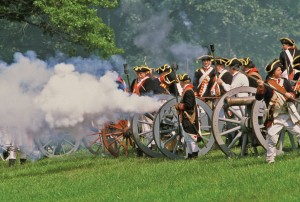 The French entry into the war placed the British in a difficult position. If the French navy blockaded the Delaware River, it could starve out the British army in Philadelphia. The British abandoned Philadelphia on June 18, 1778, and began slowly making their way across New Jersey to New York. The Continental Army caught up with them at Monmouth Courthouse on June 28, 1778.
The French entry into the war placed the British in a difficult position. If the French navy blockaded the Delaware River, it could starve out the British army in Philadelphia. The British abandoned Philadelphia on June 18, 1778, and began slowly making their way across New Jersey to New York. The Continental Army caught up with them at Monmouth Courthouse on June 28, 1778.
Monmouth was the largest battle of the American Revolution. “roughout a hot, exhausting afternoon, the biggest field artillery battle of the war raged, and heat as well as bullets felled infantrymen. Although tactically a draw, it was a strategic victory and a political triumph for the Continental Army and General Washington. The Army had absorbed its Valley Forge training and stood as equals to the British in a large, European-style engagement. The battle also was the undoing of General Charles Lee, long a thorn in Washington’s side. His order to retreat resulted in his court-martial, effectively ending his military career.
The battle is re-enacted annually in late June.
Other Sites Associated with the Battle
Before and after the battle, the Continental Army camped west of Englishtown. Major General Charles Lee was quartered in the Village Inn (2 Water Street; Limited hours; Battleground Historical Society).
Freehold Borough (then Monmouth Courthouse) was the center of huge British encampments. Near the middle of town is the 1771 St. Peter’s Church (33 Throckmorton St.), used by the British as a hospital after the battle. Three blocks north is the museum of Monmouth County Historical Association (MCHA), which has an exhibit on the Battle of Monmouth as well as changing galleries featuring decorative arts and archival collections [70 Court St., Freehold 07728; Hours Tuesday through Saturday, 10 a.m. to 4 p.m.; (732) 462-1466]. Across the street is the 1884 Monmouth Battle Monument. The 100-foot-high monument includes five bronze tablets with scenes from the battle.
Molly Pitcher
The “Molly Pitcher” of myth was a water-carrier who took over firing a cannon when her husband was killed. The real “Molly” was luckier-her husband was not killed, and she was only one member of a large gun crew. “Molly” was Mary Hays, wife of William Hays, Gunner, Captain Proctor’s company of the Pennsylvania or 4th Continental Artillery regiment. The myth evolved from memories of Mary Hays and Margaret Corbin-the latter wounded defending Fort Washington in 1776-and the hundreds of other soldiers’ wives who mended and laundered for the armies of both sides.
